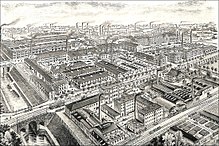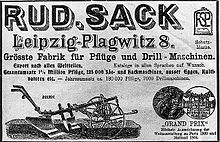Soil tillage equipment factory in Leipzig
| BBG tillage equipment Leipzig GmbH & Co. KG
|
|
|---|---|
| legal form | GmbH & Co. KG |
| founding | 1863 |
| Seat | Leipzig , Germany |
| Number of employees |
|
| Branch | Agricultural engineering |
| Website | www.amazone.de |
The BBG tillage equipment Leipzig GmbH & Co. KG is the successor company of the original as agricultural machinery factory Rudolph bag formed company. The soil tillage equipment factory in Leipzig (BBG) was one of the most important agricultural machinery manufacturers in the GDR , especially in the 1950s and 1960s . Today the company belongs to the Amazonen-Werke .
history
The origin of the company was the agricultural machinery factory Rudolph Sack founded by Rudolph Sack in Plagwitz near Leipzig in 1863 for the manufacture of agricultural equipment , which at the end of the 19th century was one of the largest agricultural machinery manufacturers in Germany.
The entrepreneur Rudolph Sack began building agricultural equipment ( plows and seed drills ) as early as 1854 in the village blacksmith's shop in Löben (now in Kitzen ) near Lützen .
At the beginning of May 1863, on the recommendation of the Leipzig lawyer and entrepreneur Karl Heine (1819–1888), he founded a machine factory in Plagwitz, which initially worked in rented rooms on Alte Strasse and had five employees.
In 1867, Sack built his own factory building and a residential building on what is now Karl-Heine-Straße 95, which was rebuilt in 1875 and later used as an office.
In 1881 he acquired further properties (today: Karl-Heine-Straße 90 and 99-101), the number of employees had risen from 60 (1868) to 170 (1878) to 650 (1881). A steel foundry with a Siemens furnace and gas generator was established around 1890.
In 1891 the Rud. Sack converted into a limited partnership ( Rud. Sack KG ), and Rudolph Sack's son Paul (1863–1923) took over management. The company expanded in 1894 to the property at Karl-Heine-Straße 103/105, where the gray foundry, which was built on the old property in 1869, was relocated; 1897 on the property at Weißenfelser Straße 67, where the factory for steam plows and seed drills was built; 1904 on the properties Karl-Heine-Straße 78–88; 1912 on the plots Aurelienstraße 62/64. In the 50th anniversary year of 1913, 2,000 employees worked in the company, which covered 75,000 m² of floor space and had three sidings.
The Rud plow factory. Until 1945 Sack was one of the leading plow and agricultural machinery manufacturers in Germany.
During the Great Depression, 1,150 employees had to be laid off in 1930; in 1932 only 65 employees and 31 apprentices were working in the company. In 1937/38 the company Leonhard (woodworking machines) was bought on the property at Klingenstrasse 22. After 1942, 1,570 forced laborers were employed in the company.
Rudolph Sack KG, which is strongly anchored in arms production, was severely destroyed by the effects of the war in 1945. In April 1945 the Rud. Sack KG was shut down by the US occupation, but production was resumed under the old company with 224 employees as early as May 1945.
On October 30, 1945 the property was confiscated by the Soviet Military Administration (SMAD). At the referendum in Saxony on June 30, 1946 , the Rud. Sack has been placed on List C (SMAD reserves the right to decide on expropriation or return). On July 1, 1946, it was taken over in trust by the state government of Saxony. In September 1947 more than 1000 employees were already working in the company.
In 1948 the expropriation took place with conversion to the state-owned company Leipziger Bodenverarbeitunggeräte (BBG) as well as the assignment to the Association of People's Own Companies Agricultural, Construction and Woodworking Machines, also located in Leipzig . With almost 1,500 employees, BBG was the largest manufacturer of agricultural machinery in the GDR at that time.
By 1950 the workforce had grown to around 2,300. This development continued, with some small and medium-sized businesses from the region being assigned to the company in the 1960s and 1970s. In 1970 the company became part of the Weimar Combine and in 1978 it was integrated into the Combine Progress Agricultural Machinery . At this point in time, BBG was given responsibility for agricultural machinery construction in Döbeln and a number of smaller companies.
In 1984 the Bernburg plant (previously the Bernburg agricultural machinery company - successor to the Siedersleben company founded in 1867 ) was assigned. In this formation the VEB tillage equipment "Karl Marx" Leipzig realized a turnover of around 470 million GDR Marks at the end of the 1980s and had around 4,100 employees, of which around 2,800 in the main plant in Leipzig, 600 in the Bernburg plant and another 700 in parts of the company Taucha, Großschirma, Colmitz and Leipzig.
In 1990 the company became an AG under trust management. Turbulent privatization activities followed, which were accompanied by a strong contraction of the company. At the end of 1993 BBG GmbH Leipzig was formed with around 150 employees, which was taken over by Franz Kleine GmbH & Co. KG at the same time . BBG GmbH Leipzig was also affected by the bankruptcy of the Kleine company in 1998. The Amazonen-Werke company has owned BBG since 1999 .
Products
Sack was a very innovative company that in the 1940s had a wide range of products in the fields of tillage, sowing, crop protection and root crop harvesting for both trailer and tractor trains. That was the basis for production in the first post-war years. Some of these products, including above all clamping technology, were still relevant until the end of the 1950s.
The further developments were determined by the motorization and the tractors available in agriculture and the specialization in agricultural machinery of the GDR .
Focal points in the 1950s (only a selection of plows for tractors from 20 to 40 hp for tillage):
- DZ 25, DZ 30 attached plows and the B 100 and B 170 attachable bed and reversible plows series
- Add-on sprayers and dusters S 291 / S 293 for the RS08 and RS09 equipment carriers as well as the S 050 series of attached plant protection machines
- Harvesting system for sugar beets with the E 710 longitudinal swath harvester and the T 274 (for beet) and T 275 (for beet leaf) damage collection devices
Focal points of the 1960s (only a selection of plows for up to 100 hp for tillage):
- Trailed bed plows B 185, B 187
- Series mounted bed plows B 200, B 201 with post-processing devices
- Plant protection machine series S 030 and S 040
- Two-machine harvesting system for sugar beet with the E 732 / E 734 head loader and the E 765 toboggan loader
Focal points in the 1970s (only a selection of plows for over 200 hp for tillage):
- Series mounted bed plows B 500 with post-processing devices
- Modular system of plant protection machines that were produced in Hungary from the early 1970s
- 6-row sugar beet harvesting system based on self-propelled vehicles, of which the self-propelled head loader was produced from the mid-1970s in Czechoslovakia near Agrostroj Jičín and the self-propelled toboggan loader KS 6 in Ternopil / Ukraine. At BBG and in the agricultural machinery manufacturing companies in Torgau and Döbeln, assemblies were produced for the final production of KS 6 in the Ukraine
In the 1980s, from the point of view of exports, there was also further development of plowing and other tillage technology for the lower tractor traction classes. Further focus:
- Series mounted bed plows B 550 with reworking devices
- B 540 semi-mounted plow with post-processing equipment
- Seedbed preparation system B 620
- Further development of the toboggan loader to the KS 6W
Priorities in the 1990s:
- Further development of the bedding, rotating and disc plows
- Disc harrow series Eurodisk 4000 to 9000
- Cultivator combinations Europak and the seedbed preparation combinations Multipak and Ökopak
- In the period up to 1993, the product range for crop protection technology with the S 320, S 330 and S 340 trailer field sprayers and the S 400 self-propelled field sprayer
Between 2000 and 2014, the AMAZONE-Werke subsidiary no longer had any plows in its range. The focus was on soil cultivation combinations with passive and active working organs. After an orientation phase on ploughless tillage, AMAZONE decided in 2013 to resume production of plows at the traditional Leipzig location. For this purpose, a new production hall was built in the same year. Series production of plows there started again in 2014.
See also
literature
- Traditional association KOFO Neustadt / Sa. eV (Hrsg.): The people's own combine progress agricultural machinery Neustadt in Saxony and its operations 1945–1990. Neustadt in Saxony 2005.
- Jan Welkerling: "Progress" in all ears. Self-published , Nuremberg 2005.
- Klaus Krombholz: Agricultural machinery in the GDR. Light and shadow. 4th revised edition, DLG-Verlag, Frankfurt am Main 2008, ISBN 978-3-7690-0717-6 .
- Manfred Rustig: BBG. Agricultural machinery construction in Leipzig. (= Mensch und Werk , Volume 4.) Vokal-Verlag Opitz-Karig, Leipzig 2008, ISBN 978-3-9810418-8-0 .
- Jan Welkerling: "Progress" in the market economy. Self-published, Nuremberg 2011
- Rudolf Hundhausen: Rudolf Sack factory for agricultural equipment, ... In: The German Industry (1888-1913), Berlin 1913 pp. X121-X123.
- Klaus Dreyer: The history of BBG. From Rudolph Sack to Amazone. The checkered history of a traditional East German brand. DLG-Verlag, Frankfurt am Main 2009, ISBN 978-3-7690-0750-3 .
- Eckart Roloff : He was there early when it came to modern agricultural technology. With a lot of inventive talent and foresight, Rudolph Sack from Saxony developed a model factory and research institute from a small plow business. In: Landwirtschaftliche Zeitschrift Rheinland ISSN 0724-5580 , edition 27/2010, page 42 f.
- Otto Sack: The Chronicle of the House of Rud. Sack Leipzig - 1863–1938, published for the 75th anniversary , Leipzig 1938
Web links
- BBG Bodenarbeitungsgeräte Leipzig GmbH & Co. KG , last accessed on April 8, 2015
- www.ddr-landmaschinen.de , homepage of the author Jan Welkerling, last accessed on April 8, 2015
Individual evidence
- ↑ http://d-nb.info/361662602 - accessed on August 10, 2019




